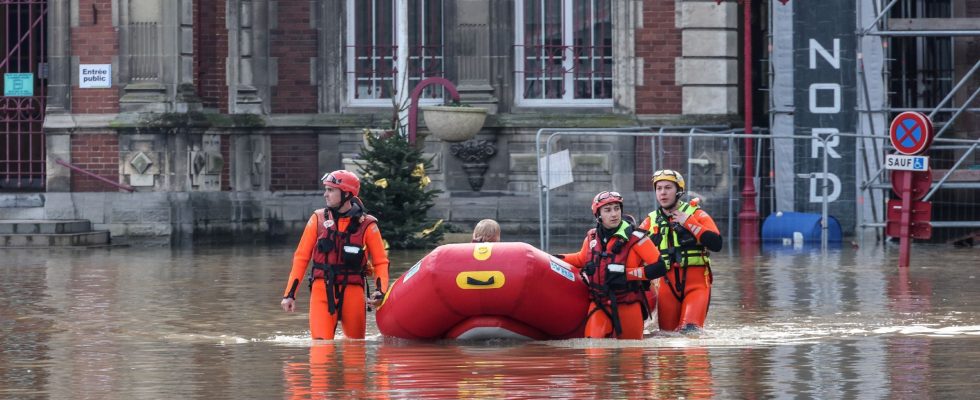The day ends, and Alain Méquignon can take a breather. The president of the Joint Syndicate for the development and management of water of the Aa ran all day Wednesday to deal with the most pressing needs. Since December 31, rain has fallen continuously on the Pas-de-Calais department, causing the rivers to overflow and flooding the region, made up of market gardening plains, large crops, and polders. After the already historic floods of November, the Aa, a coastal river crossing the department, “is generally at the same level as in November”, when it reached its highest historical level, indicates Vigicrues. Levels could still increase “very slightly”, but “we can consider that we are at the peak of this flood”, adds the organization. Aerial images of Esquerdes, near Blendecques, reveal entire blocks of houses underwater and torrents of muddy water rushing down gardens. In total, more than 300 people have been evacuated in recent days in the northern department. While more than 10,000 homes were deprived of electricity on Wednesday in the Nord and Pas-de-Calais, 95% of them were replenished by the end of the day, indicated the manager of the distribution network of electricity Enedis. Bottled water distributions were underway on Thursday, with 2,100 residents deprived of drinking water, adds the prefecture.
Residents are worried about these seemingly endless floods, and are worried about having to relive the November episode which had already plunged more than 280 communities underwater. “Since October 15, we have been witnessing a parade of ocean disturbances, which are leading to accumulations of rain never before observed,” underlines Mathieu Sorel, climatologist at Météo France. Falling on soils already saturated with water, new precipitations have continued since December 31. “In certain towns in Pas-de-Calais, we reach 800 mm, which is more than the accumulation of normal precipitation in autumn and winter combined,” notes the specialist.
Lessons to learn
Beyond precipitation, the morphology of the territory also explains the importance of the phenomenon. Surrounded by small reliefs, the very flat plains of the region are quickly affected by runoff from the rivers in the valleys that surround it. Polders (these lands located below sea level) extend, dotted with canals and Wateringues. These water drainage systems, typical of the region, usually allow the water to be evacuated towards the sea. But the rains of recent weeks make them unusable, and to this is added the conjunction of a particularly maritime phenomenon. unwelcome. “Evacuation to the sea is located 30 km from our commune, but the current tidal coefficients make evacuation by gravity much too slow,” explains François Decoster, the mayor of Saint-Omer, a particularly affected commune located in start of a polder. The territory is therefore suspended from the arrival of giga pumps, capable of removing part of the stagnant water on these lands. “Four pumps from the Netherlands, two pumps from the Czech Republic and two pumps from Slovakia” left “towards the Nord and Pas-de-Calais” as part of the civil protection mechanism of the European Union, the European Commission announced on its website on Wednesday.
On the ground, the question of the region’s adaptation to climate change is on everyone’s lips. “We have entered a time where the manifestations of climate change are more and more numerous,” recognized, in the preamble to his trip to the department, the Minister of Ecological Transition, Christophe Béchu. Projections from IPCC scientists also show that in a climate warmed by human activities, the coming years could generate greater accumulations of precipitation in Northern Europe and in particular in northern France. “There are many lessons to be learned from this type of episode,” underlined Christophe Béchu.
An uninhabitable region?
Already in 2002 the region was faced with monster floods, forcing major local adaptations. “We invested 20 million euros to control the floods,” explains Alain Méquignon of Smage Aa. Citing the controlled flood fields, which can contain 610,000 and 630,000 m³ of water, bunds and weirs to contain the water… “This work paid off during previous episodes, but when it rains for two and a half months that cannot be enough,” he whispers. Following the November floods, dozens of actions were launched, also underlined the Minister of Transition, but not all of them had time to be implemented. “In three days, the French Waterways will begin dredging operations on certain canals, but before that we had to go see the farmers to be sure that they were being done in the right place, and because we had to get started. “agreement with everyone”, he explained on Wednesday, adding: “No one imagined at the beginning of December, when these measures were activated, that we would have situations of this type from January”.
Would the region become uninhabitable? Some, like Alain Méquignon, refuse to give in to fatalism. The adaptation strategy which is carried out locally by the Water Agencies and specified in the water development and management master plans consists of retaining rainwater where it falls. “But it will also be necessary to change the working methods on agricultural land, the hedges have been uprooted and they must be replanted, the land has been turned over and water no longer infiltrates there, which means that we must review our land management,” he pleads. With the hope that such events remain exceptional.
.
